|
|

This chapter describes the typical tasks you should complete to get started with the Cisco 6400 Service Connection Manager (SCM). See Figure 3-1 for further details.

Refer to the Cisco Element Management Framework Installation and Licensing Guide for further information.
Before you can launch the Cisco 6400 SCM application, you must start a Cisco EMF user session. Launch the Cisco 6400 SCM application from the Cisco EMF launchpad. Each active Cisco EMF session uses a single Cisco EMF user license.
 |
Note Cisco EMF should already be running. When (upon starting) you receive a message that Cisco EMF is not running, contact your system administrator, or refer to the Cisco Element Management Framework User Guide for further details. |
To start a Cisco EMF user session, follow these steps:
 |
Note <CEMFROOT> is the Cisco EMF installation root directory (for example, /opt/CEMF). |
The Login window (see Figure 3-2) appears:

Step 2 Enter your user name and password.
Step 3 Click Ok to proceed.
When an unknown user name or password is entered, an error displays. Click Ok, then enter a valid user name and password.
 |
Note You have three attempts to enter a valid user name and password. If you do not enter a valid user name and password after three attempts, the session does not start and the Login window closes. |
When you enter a valid user name and password, the session starts and the Cisco EMF Launchpad window (see Figure 3-3) appears.
The icons displayed in the Cisco EMF Manager panel on the Launchpad represent applications that are provided by this Cisco EMF installation. Extra icons may appear when additional packages are installed. The icons (see Figure 3-3) represent the standard Cisco EMF tools.
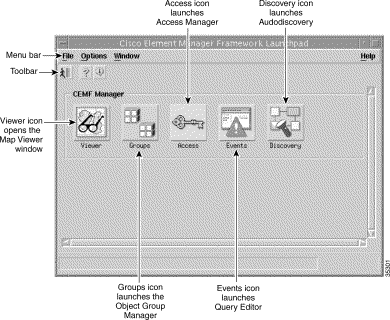
The Cisco EMF MapViewer application allows complete flexibility in viewing, building, and monitoring your network using graphical representations of network elements.
MapViewer is the primary entry point into the Cisco 6400 SCM. When the MapViewer application is launched, a window appears corresponding to the highlighted map icon in the hierarchy pane. You can monitor the status of all network elements or abstractions of elements contained within the network and you can launch any of the additional applications on the Cisco EMF Launchpad.
Click the Viewer icon (see Figure 3-4) to launch the MapViewer application or select Map Viewer from a pop up menu when using other Cisco EMF applications. The pop up menu is accessed by right clicking a selected object.

Refer to the Cisco Element Management Framework User Guide for further details on the Cisco EMF MapViewer application.
Object groups can be built manually or by building a query. Some Cisco EMF subsystems may also build object groups which are visible and usable by the Cisco EMF user.
Click the Groups icon (see Figure 3-5) to launch the Cisco EMF Object Group Manager application or select Groups from a pop up menu when using other Cisco EMF applications. Access the pop up menu by right clicking a selected object.

Refer to the Cisco Element Management Framework User Guide for further details on the Cisco EMF Object Group Manager application.
Cisco EMF User Access Control allows system administrators to control the features of their system that various levels of personnel can access. This is important for secure network management.
Click the Access icon (see Figure 3-6) to launch the Cisco EMF User Access Control application or select Access from a pop up menu when using other Cisco EMF applications. Access the pop up menu by right clicking a selected object.

Refer to the Cisco Element Management Framework User Guide for further details on the Cisco EMF User Access Control application.
In Cisco EMF, when a condition (fault) occurs on a managed object in the network which results in an SNMP trap, the system is notified immediately. Notification is shown as an event and can be viewed with the Cisco EMF Event Browser (when configured to do so).
You can launch the Event Browser application by performing any one of the following:
1. Click the Events icon (see Figure 3-7) in the Cisco EMF Launchpad window.

2. From the pop up menu available when you right click one or more objects in the Map Viewer (the Event Browser displays only the events associated with the selected object).
3. From other Cisco EMF applications, select the Event Browser option from the pop up menu available when you right click a selected object.
Refer to the Cisco Element Management Framework User Guide for further details on the Event Browser application.
The Cisco EMF Auto-discovery application allows you to:
Auto-discovery can be opened from the Cisco EMF Launchpad window or from a pop up menu available on a selected object.
Click the Discovery icon (see Figure 3-8) to launch the Cisco EMF Auto-discovery application or select Discovery from a pop up menu when using other Cisco EMF applications. Right click a selected object to access the pop up menu.

Refer to the Cisco Element Management Framework User Guide for further details on the Cisco EMF Auto-discovery application.
 in the Toolbar.
in the Toolbar.
Step 2 A window appears asking, Do you wish to quit the Cisco EMF Manager System?. Click Yes to quit the session. All active applications are closed and the session terminates.
 |
Note You must install and start a licensed version of the full Cisco EMF application before you install the Cisco 6400 SCM application. |
Refer to the Cisco 6400 Service Connection Manager Installation Instructions for further information. The Cisco 6400 Service Connection Manager Installation Guide is available in PDF format on the CD-ROM containing the Cisco 6400 SCM software.
Before you can use the Cisco 6400 SCM to manage the Cisco 6400 UAC you must perform basic configuration changes, using Cisco IOS commands, which might need to be run on your Cisco 6400 UAC.
Refer to the appropriate section in the Cisco 6400 Service Connection Manager Installation Guide for further information. The Cisco 6400 Service Connection Manager Installation Instructions are available in pdf format on the CD-ROM containing the Cisco 6400 SCM software.
You must start a Cisco EMF user session before you can launch the Cisco 6400 SCM application.
MapViewer is the primary entry point into the Cisco 6400 system. MapViewer provides you with complete flexibility in viewing, building, and monitoring your network using graphical representations of network elements.
Click the Viewer icon (see Figure 3-3) to launch the MapViewer application or select Map Viewer from a pop up menu when using other Cisco EMF applications. The pop up menu is accessed by right clicking a selected object.
When the MapViewer application is launched for the first time, a window (similar to the one shown in Figure 3-10) appears.
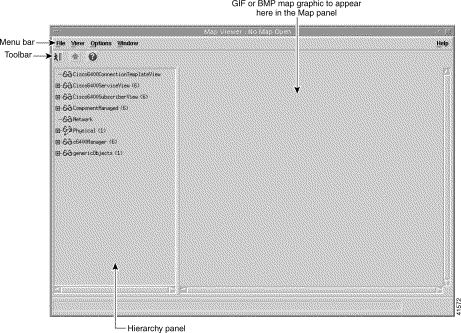
Use the Cisco EMF Viewer application to:
1. Deploy regions and sites from the Physical view.
2. Set appropriate map backgrounds using the Map editing facilities (that is, use GIF or BMP graphics of the maps you wish to show).
 |
Note Refer to the Cisco Element Management Framework User Guide for further details. |
Figure 3-10 shows an example of how the MapViewer window looks after deploying regions and sites and setting the appropriate map background. You can easily monitor the status of all network elements or abstractions of elements contained within the network and you can launch any of the additional applications shown on the Cisco EMF Launchpad.
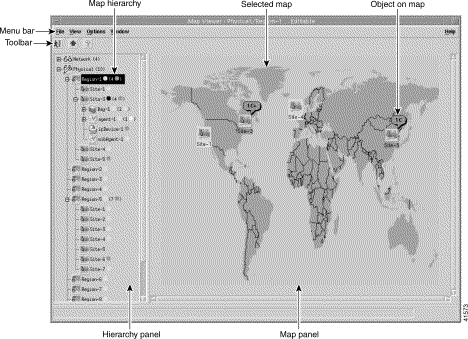
The Hierarchy panel and Map panel can be resized by positioning your cursor over the boundary; left click with the mouse, then drag the boundary. You can view all information in the left and right panels using the scroll bars.
You can select one or more object(s) and right click. This displays the list of services available on an object in a pop up menu. The services available depends on the class of that object and is enabled or disabled according to the access of the user.
The deployment process should be carried out after starting the Cisco 6400 SCM for the first time or after installing new hardware or network elements. Deployment informs the Cisco 6400 SCM of the presence of supported network elements.
The Cisco 6400 SCM objects can be deployed manually or automatically by launching a wizard-style deployment tool that enables you to automatically deploy a network modeled in Cisco EMF. The deployment wizard also enables you to (optionally) deploy objects in Cisco EMF in advance of actual deployment of a Cisco 6400 UAC in the field.
Deployment is one of the first stages of the provisioning process. Deployment is the first stage of equipment provisioning. It is also referred to as pre-provisioning--meaning that part of the network hardware setup before the service is actually provisioned. After objects are deployed, the initial state of all objects is normal.
The 6400 SCM provides a Quick Start deployment option that guides you through the most commonly used deployment process, resulting in a fully-discovered 6400 chassis (see Figure 3-11). Full details of the various alternative Cisco 6400 SCM Deployment Options are described in "Cisco 6400 Service Connection Manager Deployment.".

 |
Note Quick Start deployment assumes that the IOS CLI Telnet and IOS CLI Enable Passwords are (respectively) identical on both the NSP and each NRP. This is common in operational environments. When the NSP and NRP passwords are different, you can reset the NRP password at the end of this process. Alternatively, see "Cisco 6400 Service Connection Manager Deployment." for a full description of Cisco 6400 SCM deployment options. |
To launch Quick Start deployment, follow these steps:
Step 2 Place the cursor over the relevant site object you created from the Physical View.
Step 3 Click and hold down the right mouse button.
Step 4 Select the Deployment, Cisco 6400 UAC, Deploy Cisco 6400 UAC (Quick Start) option. The Deployment Wizard - Object Parameters window (1 of 3) appears (see Figure 3-12).
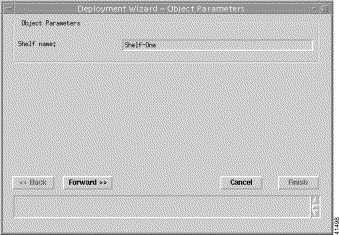
Step 5 Enter a Shelf name. A Shelf is an object that acts as a container for chassis objects. Each Shelf object must have a unique name for deployment to be successful.
Step 6 Click Forward. The Deployment Wizard - Object Parameters window (2 of 3) appears (see Figure 3-13).
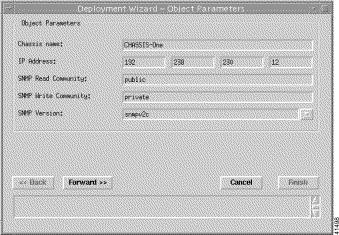
Step 7 Enter a Chassis name, IP Address (for the primary NSP), SNMP Read Community, the SNMP Write Community and select an SNMP Version.
Step 8 Click Forward. The Deployment Wizard - Object Parameters window (3 of 3) appears (see Figure 3-14).
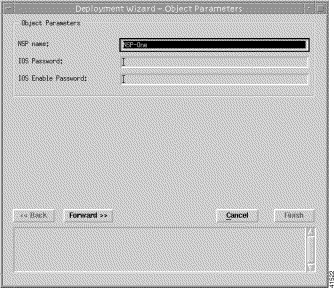
Step 9 Enter an NSP name, IOS Password, and IOS Enable Password.
 |
Note The IOS Password and IOS Enable Password must be the same as the CLI passwords entered on the Cisco 6400 NSP Management window (Configuration tab). See the "Configuration Tab" section for further details. |
Step 10 Click Forward. The Deployment Summary details appear in the Deployment Summary Screen.
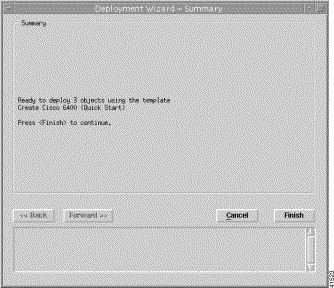
Step 11 Click Finish (when the Deployment Summary information is correct) to complete the deployment (creating the relevant objects in the Cisco EMF) and close the Deployment Summary Screen.
 |
Note To view a chassis map of the chassis and card objects that you created using the quick start deployment option, double click the Shelf object you just created in the c6400Manager. See "Viewing the Cisco 6400 SCM Chassis Map" section for further details. |
 |
Note After deployment you may wish to start global performance logging for one or more selected chassis. See the "Starting Global Performance Logging" section for further details. |
![]()
![]()
![]()
![]()
![]()
![]()
![]()
![]()
Posted: Fri Aug 4 01:43:53 PDT 2000
Copyright 1989-2000©Cisco Systems Inc.